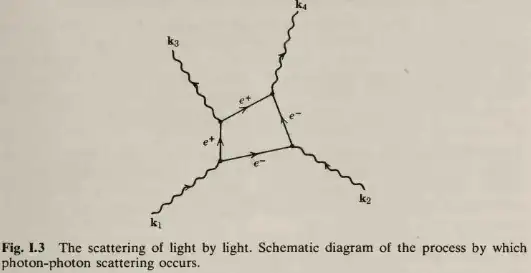Maxwell's equations are famously linear and are the classical limit of QED. The thing is QED even without charged particles is pretty non-linear with photon-photon interaction terms. Can these photon-photon interaction terms have a "classical" limit as well? Can we just perturbatively expand the QED Lagrangian and find the classical limit of certain non-linear terms?
3 Answers
In Quantum Electrodynamics by A. I. Akhiezer; V. B. Berestetskii, photon-photon scattering is considered in paragraph 54, and the effective classical Lagrangian for nonlinear vacuum electrodynamics is derived in 54.3 (see Equation 54.14 and further). The nonlinear correction is written as $$ L_1 = a\left(E^2 - H^2\right)^2 + b(\vec{E}\vec{H})^2. $$
These terms arise from 4-point electron loop diagrams. To my knowledge, they can be found in two steps:
- The perturbative expansion of the effective action for EM field interacting with charged fermions (or whatever) in one-loop order,
- Gradient expansion in order to make the action local.
- 1,123
In addition to what the other answer already mentions, the non-linear extension required to include QED effects classically can also be found in [Jackson].
But the claim the question makes, that "even without charged particles" the theory is non-linear is debatable. The nonlinear terms always come from interaction with the electron, as in Jackson's [Fig. 1.3].

The question also asks specifically for a second order nonlinear addition, but the nonlinearities we find are in fact third order. They can be expressed (as Jackson does) as 2nd order additions to the permittivity and permeability of vacuum, but in the Maxwell equations those quantities appear multiplied with the fields so they become third order.
- 6,031
Good answers. I just want to add that
as I commented electromagnetism is strictly linear without coupling to charged
if there ís coupling to charges or spins then upon integrating out the virtual charge or spin degrees of freedom you should quite generally end up with effectively nonlinear electromagnetism expressible in the invariants $F_{\mu\nu} F^{\mu\nu}$ and $\epsilon^{\mu\nu\rho\sigma} F_{\mu\nu} F_{\rho\sigma}$.
- 27,443
